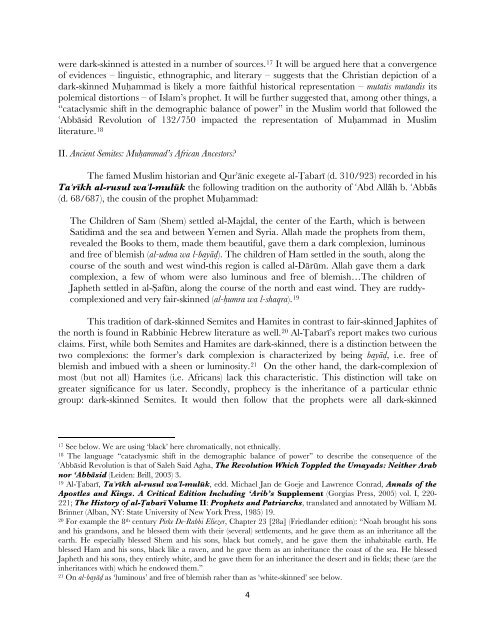“Anyone who says that the Prophet is black should be killed”: The ...
“Anyone who says that the Prophet is black should be killed”: The ...
“Anyone who says that the Prophet is black should be killed”: The ...
You also want an ePaper? Increase the reach of your titles
YUMPU automatically turns print PDFs into web optimized ePapers that Google loves.
were dark-skinned <strong>is</strong> attested in a num<strong>be</strong>r of sources. 17 It will <strong>be</strong> argued here <strong>that</strong> a convergence<br />
of evidences – lingu<strong>is</strong>tic, ethnographic, and literary – suggests <strong>that</strong> <strong>the</strong> Chr<strong>is</strong>tian depiction of a<br />
dark-skinned MuÈammad <strong>is</strong> likely a more faithful h<strong>is</strong>torical representation – mutat<strong>is</strong> mutand<strong>is</strong> its<br />
polemical d<strong>is</strong>tortions – of Islam’s prophet. It will <strong>be</strong> fur<strong>the</strong>r suggested <strong>that</strong>, among o<strong>the</strong>r things, a<br />
“cataclysmic shift in <strong>the</strong> demographic balance of power” in <strong>the</strong> Muslim world <strong>that</strong> followed <strong>the</strong><br />
#Abb§sid Revolution of 132/750 impacted <strong>the</strong> representation of MuÈammad in Muslim<br />
literature. 18<br />
II. Ancient Semites: MuÈammad’s African Ancestors?<br />
<strong>The</strong> famed Muslim h<strong>is</strong>torian and Qur"§nic exegete al-•abarÊ (d. 310/923) recorded in h<strong>is</strong><br />
Ta"rÊkh al-rusul wa"l-mulåk <strong>the</strong> following tradition on <strong>the</strong> authority of #Abd Allāh b. #Abbās<br />
(d. 68/687), <strong>the</strong> cousin of <strong>the</strong> prophet MuÈammad:<br />
<strong>The</strong> Children of Sam (Shem) settled al-Majdal, <strong>the</strong> center of <strong>the</strong> Earth, which <strong>is</strong> <strong>be</strong>tween<br />
Satidim§ and <strong>the</strong> sea and <strong>be</strong>tween Yemen and Syria. Allah made <strong>the</strong> prophets from <strong>the</strong>m,<br />
revealed <strong>the</strong> Books to <strong>the</strong>m, made <strong>the</strong>m <strong>be</strong>autiful, gave <strong>the</strong>m a dark complexion, luminous<br />
and free of blem<strong>is</strong>h (al-udma wa l-bay§∙). <strong>The</strong> children of Ham settled in <strong>the</strong> south, along <strong>the</strong><br />
course of <strong>the</strong> south and west wind-th<strong>is</strong> region <strong>is</strong> called al-D§råm. Allah gave <strong>the</strong>m a dark<br />
complexion, a few of <strong>who</strong>m were also luminous and free of blem<strong>is</strong>h…<strong>The</strong> children of<br />
Japheth settled in al-‘afån, along <strong>the</strong> course of <strong>the</strong> north and east wind. <strong>The</strong>y are ruddycomplexioned<br />
and very fair-skinned (al-Èumra wa l-shaqra). 19<br />
Th<strong>is</strong> tradition of dark-skinned Semites and Hamites in contrast to fair-skinned Japhites of<br />
<strong>the</strong> north <strong>is</strong> found in Rabbinic Hebrew literature as well. 20 Al-•abarÊ’s report makes two curious<br />
claims. First, while both Semites and Hamites are dark-skinned, <strong>the</strong>re <strong>is</strong> a d<strong>is</strong>tinction <strong>be</strong>tween <strong>the</strong><br />
two complexions: <strong>the</strong> former’s dark complexion <strong>is</strong> characterized by <strong>be</strong>ing bay§∙, i.e. free of<br />
blem<strong>is</strong>h and imbued with a sheen or luminosity. 21<br />
17 See <strong>be</strong>low. We are using ‘<strong>black</strong>’ here chromatically, not ethnically.<br />
18 <strong>The</strong> language “cataclysmic shift in <strong>the</strong> demographic balance of power” to descri<strong>be</strong> <strong>the</strong> consequence of <strong>the</strong><br />
#Abb§sid Revolution <strong>is</strong> <strong>that</strong> of Saleh Said Agha, <strong>The</strong> Revolution Which Toppled <strong>the</strong> Umayads: Nei<strong>the</strong>r Arab<br />
nor ‘Abbāsid (Leiden: Brill, 2003) 3.<br />
19 Al-•abarÊ, Ta"rÊkh al-rusul wa"l-mulåk, edd. Michael Jan de Goeje and Lawrence Conrad, Annals of <strong>the</strong><br />
Apostles and Kings. A Critical Edition Including ‘Arib’s Supplement (Gorgias Press, 2005) vol. I, 220-<br />
221; <strong>The</strong> H<strong>is</strong>tory of al-•abarÊ Volume II: <strong>Prophet</strong>s and Patriarchs, translated and annotated by William M.<br />
Brinner (Alban, NY: State University of New York Press, 1985) 19.<br />
20 For example <strong>the</strong> 8th century Pirke De-Rabbi Eliezer, Chapter 23 [28a] (Friedlander edition): “Noah brought h<strong>is</strong> sons<br />
and h<strong>is</strong> grandsons, and he blessed <strong>the</strong>m with <strong>the</strong>ir (several) settlements, and he gave <strong>the</strong>m as an inheritance all <strong>the</strong><br />
earth. He especially blessed Shem and h<strong>is</strong> sons, <strong>black</strong> but comely, and he gave <strong>the</strong>m <strong>the</strong> inhabitable earth. He<br />
blessed Ham and h<strong>is</strong> sons, <strong>black</strong> like a raven, and he gave <strong>the</strong>m as an inheritance <strong>the</strong> coast of <strong>the</strong> sea. He blessed<br />
Japheth and h<strong>is</strong> sons, <strong>the</strong>y entirely white, and he gave <strong>the</strong>m for an inheritance <strong>the</strong> desert and its fields; <strong>the</strong>se (are <strong>the</strong><br />
inheritances with) which he endowed <strong>the</strong>m.”<br />
21 On al-bay§∙ as ‘luminous’ and free of blem<strong>is</strong>h raher than as ‘white-skinned’ see <strong>be</strong>low.<br />
4<br />
On <strong>the</strong> o<strong>the</strong>r hand, <strong>the</strong> dark-complexion of<br />
most (but not all) Hamites (i.e. Africans) lack th<strong>is</strong> character<strong>is</strong>tic. Th<strong>is</strong> d<strong>is</strong>tinction will take on<br />
greater significance for us later. Secondly, prophecy <strong>is</strong> <strong>the</strong> inheritance of a particular ethnic<br />
group: dark-skinned Semites. It would <strong>the</strong>n follow <strong>that</strong> <strong>the</strong> prophets were all dark-skinned
















